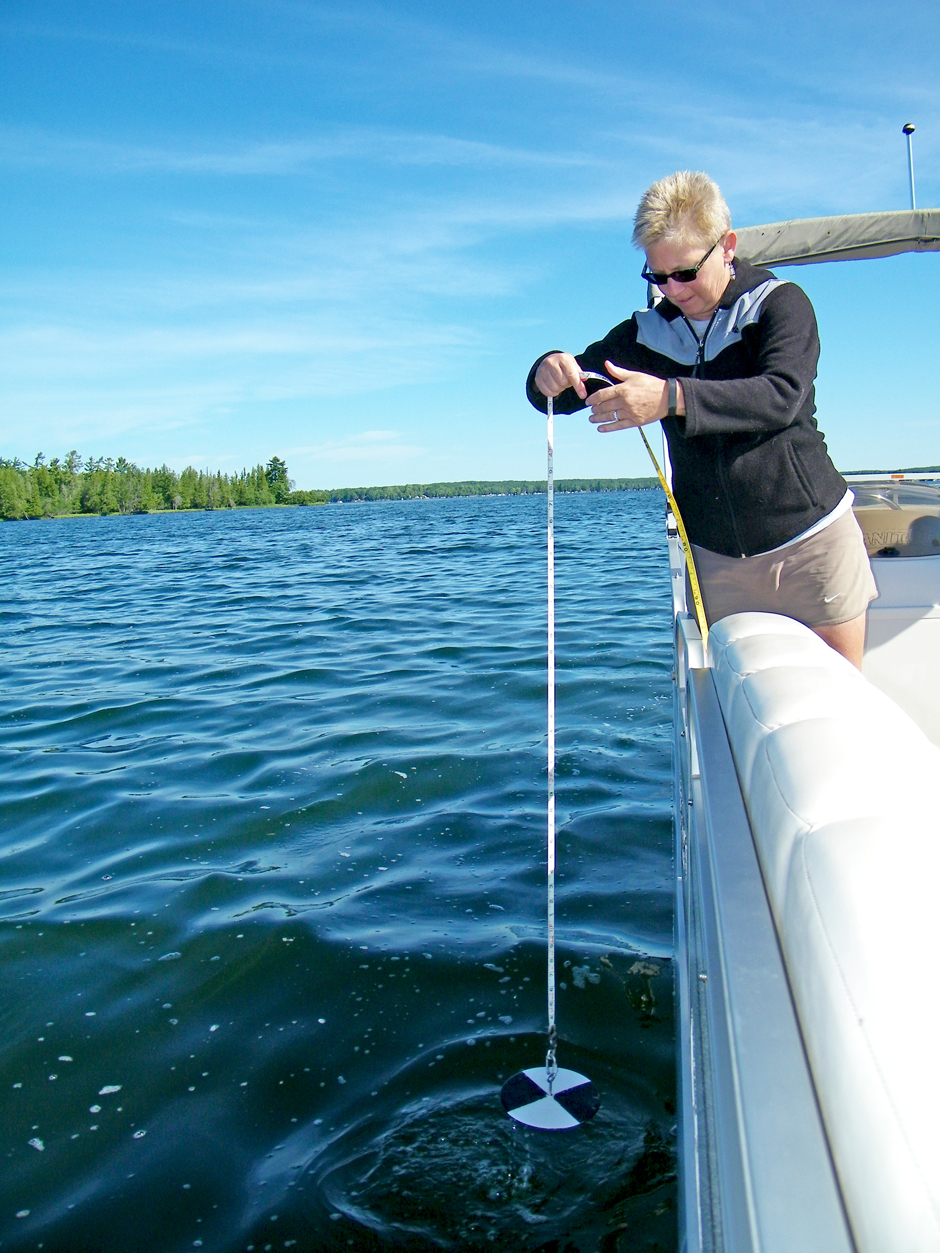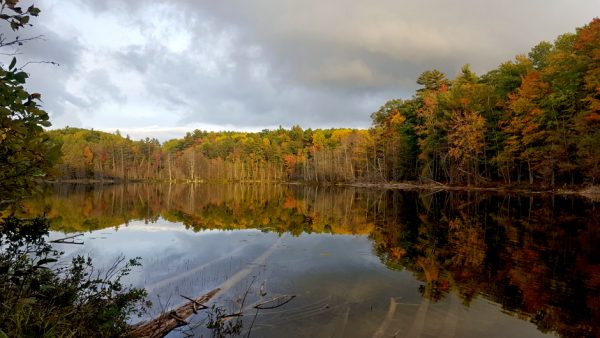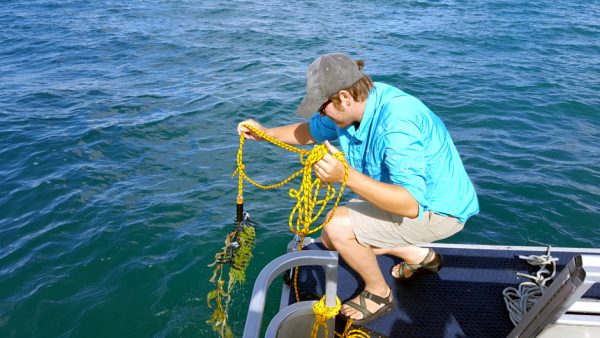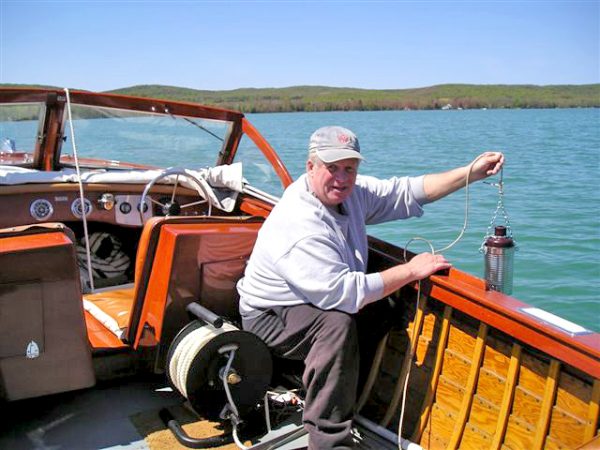Engaging People, Engaging Lakes: How The Public Can Help Aquatic Systems
 A MiCorps volunteer uses a Secchi disk to measure lake clarity. (Credit: Jo Latimore)
A MiCorps volunteer uses a Secchi disk to measure lake clarity. (Credit: Jo Latimore)Jo Latimore’s interest in aquatic ecology dates back to her childhood, spending time at her parents’ North Michigan cabin, exploring the water nearby. Today she is a senior academic specialist, aquatic ecologist, and outreach specialist at Michigan State University in the Department of Fisheries and Wildlife, in her thirteenth year in the position. Latimore’s primary interests include lake appreciation and engagement.
“Most people appreciate our lakes. They like to look at, fish on, and boat on them. However, they don’t necessarily appreciate our lakes as an ecosystem,” Latimore said. “It’s the health of the lakes that lets us use them recreationally. We use our educational programs to give people the information they need to help keep our lakes healthy so we can continue to enjoy them for years to come.”
Many important issues currently face Michigan waterways.

Ransom Lake is a small northern Michigan lake undisturbed by shoreline development. (Credit: Jo Latimore)
“We’re seeing invasive plants and invertebrates in all waterways, including inland lakes and shorelines. We’re also trying to mitigate the effects of residential development,” said Latimore. Invasive plants include Eurasian watermilfoil. In the Great Lakes there is lots of international shipping, and Eurasian watermilfoil likely originates from ship ballast. “It’s also proven to be especially hard to eradicate because, while there is herbicide that can treat it, it can unfortunately hybridize with native Northern watermilfoil, and some of these hybrids are unaffected by the herbicide,” Latimore explained.
Another, newer invader is the New Zealand mudsnail. It eats lots of algae, leaving little for native species to consume. “They have been hard to deal with because they’re very tiny and easy to miss,” said Latimore. “They may be coming from people’s waders when they go from one spot to another to fish.”
As far as invasive fish, Latimore said that fortunately, there are no Asian carp in inland water in Michigan so far, unlike in many other places. On the other hand, they do sometimes see aquarium releases, mainly goldfish, who grow fast, eat a lot, reproduce fast, outcompete native species, and spread diseases to native fish.
Residential development is another issue Michigan faces. To determine the impact of the residential development on ecological connections, Latimore and her team with the Michigan Clean Water Corps (MiCorps) program teach volunteers to “score the shore” which means dividing the lake into sections and grading them using a variety of factors that illustrate how successfully wildlife will be able to live in the area.
One scoring method used is whether the area passes “the turtle test.” Essentially, this test asks: can a turtle still travel from the lake up onto the shore and do its normal activities, such as breeding and/or finding food? Another scoring method involves rating the shoreline: is natural vegetation growing at and around the shoreline? “We hope to see native flowering vegetation, tall vegetation, deep rooted vegetation, trees, and shrubs. We also want to see riparian areas,” mentions Latimore. “These preserve the shoreline and prevent erosion, and they’re good for wildlife. Mowed vegetation, on the other hand, gets a low score. Grass is not good because its root system is so short (only 1-2 inches). It doesn’t prevent erosion like native vegetation, and most wildlife doesn’t thrive on turf grass.”

A MiCorps volunteer collects plants during a lake survey. (Credit: Jo Latimore)
What can the public do to help lakes? Latimore said there is a lot they can do and have already been doing. “The public is the main thing that helps our aquatic systems,” Latimore said. “We heavily depend on volunteer collected data sets. We educate our volunteers in what degradation looks like, and they can see it firsthand. That makes them more confident to speak up about issues.”
Gathering data gets the public to personally engage with the lake. “While people who fish the lakes tend to understand that the number of fish they find is directly related to lake health, hands-on sampling helps them connect even more with the lakes,” explained Latimore. In addition to those who fish, many volunteers who collect data are owners of lakefront properties who want to do their part to help protect the lakes.
“We train our volunteers; they don’t need a science background,” said Latimore. However, more experienced volunteers can gather different types of data, such as chlorophyll monitoring data in the summer months and dissolved oxygen monitoring. Advanced volunteers can map the whole lake for plant management.
Stream monitoring data has been gathered since the 1990s. Other data gathered includes macroinvertebrate monitoring, vegetation, depth and width of channels, substrates, and wood structures in streams. MiCorps is the network of volunteer water quality monitoring programs under which all the data is organized. Generally, the programs are aimed at adult volunteers, though sometimes teachers participate and bring their students along. Older students can sometimes get involved on an individual basis.

A MiCorps volunteer collects a water sample for chlorophyll analysis. (Credit: MiCorps)
Latimore also finds it important to deliberately choose types of monitoring that will appeal to volunteers to encourage them to get and stay engaged. “Aquatic entomology is basically the use of insects to gauge aquatic health. Some insects are especially sensitive to pollution, sediment loading, and oxygen amount, so we monitor them to determine aquatic health. Those insects include stoneflies and caddisflies. However, the public likes some other types of charismatic insects, such as dragonflies, so we monitor those too, since the public has an interest…even though dragonflies are not that sensitive to pollution. They are ambush predators, so they do need a good base of insects for prey. So their presence or absence can also give us a clue about aquatic health,” she explained.
In the future, Latimore hopes a very popular Introduction to Lakes online class offered by MSU to the public will continue to attract students. Funding and support for a similar Introduction to Streams class for the public have already been secured. While current volunteers are largely lake property owners, Latimore hopes to engage more non-owners in the future as well, since many people use the lakes besides lakeside property owners.
Lake appreciation, especially as an ecological system, will always be a theme in Latimore’s interactions with the public. “In a way, we ‘suffer from abundance’ here,” Latimore mentioned. “We have so many high quality lakes that people can take their health for granted. But in reality, it takes work to keep lakes and streams healthy and free from erosion, invasive species, and other problems.” But with the public’s help, and using a proactive approach, we hope to keep our Michigan waters places everyone can enjoy now and many years from now. Share on X




0 comments